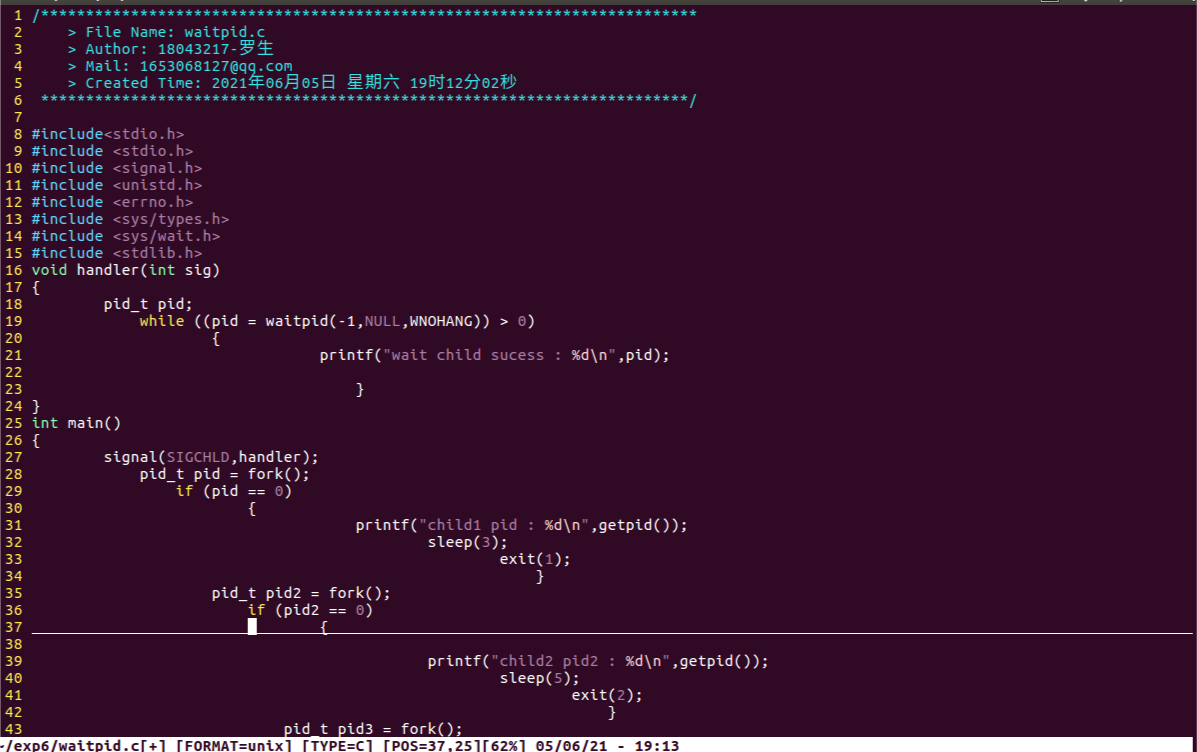实验六 进程基础
| 项目 | 内容 |
| ---- | ---- | ---- |
| 这个作业属于哪个课程 | 2021春季Linux系统与应用(南昌航空大学-信息工程学院) | |
| 这个作业的要求在哪里 | 实验六 进程基础 | |
| 学号-姓名 | 18043217-罗生 | |
| 作业学习目标 | (1)掌握Linux系统环境C语言编程概念;(2)学习Linux系统进程概念。 | |
1、请举例说明静态链接库的创建与使用。
ar:静态函数库创建的命令
-c :create
-r :replace
表示当前插入的模块名已经在库中存在,则替换同名的模块;
如果若干模块中有一个模块在库中不存在,ar显示一个错误信息,并不替换其他同名的模块。

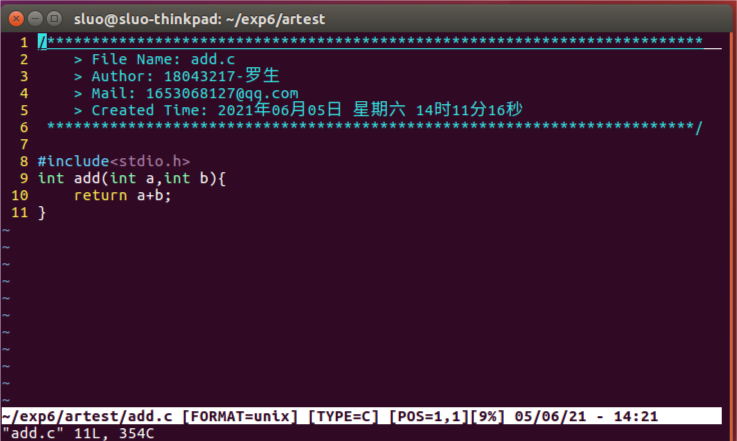


2、请举例说明共享库的创建与使用。
开始的目录结构:
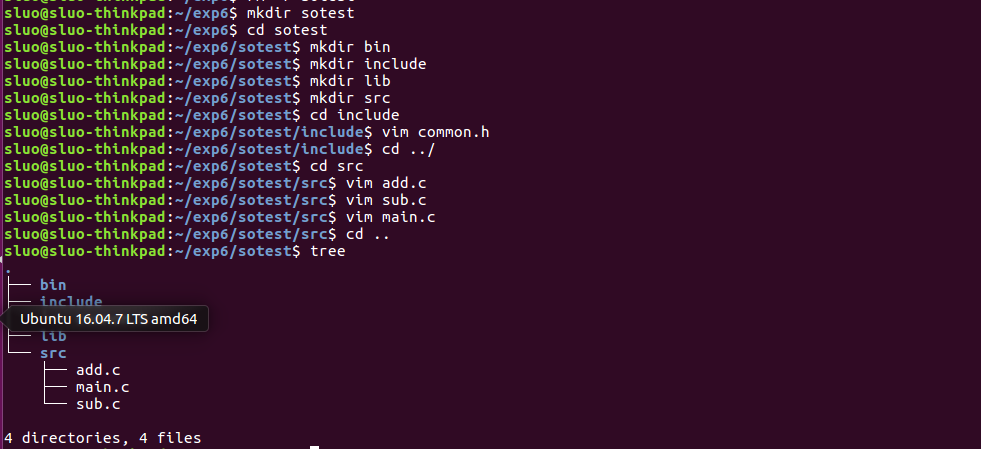
观察下面的目录结构,与开始的目录结构对比:
(1)创建共享库
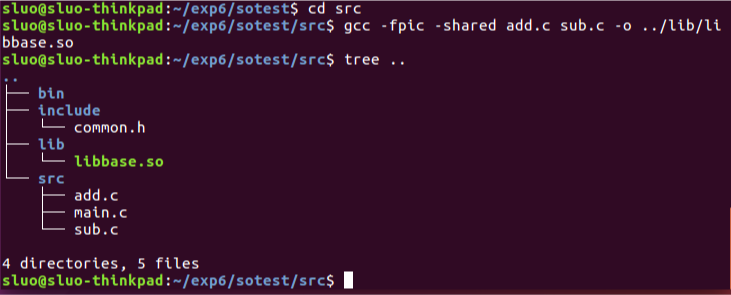
(2)使用自己的共享库
方式一:指定相对路径
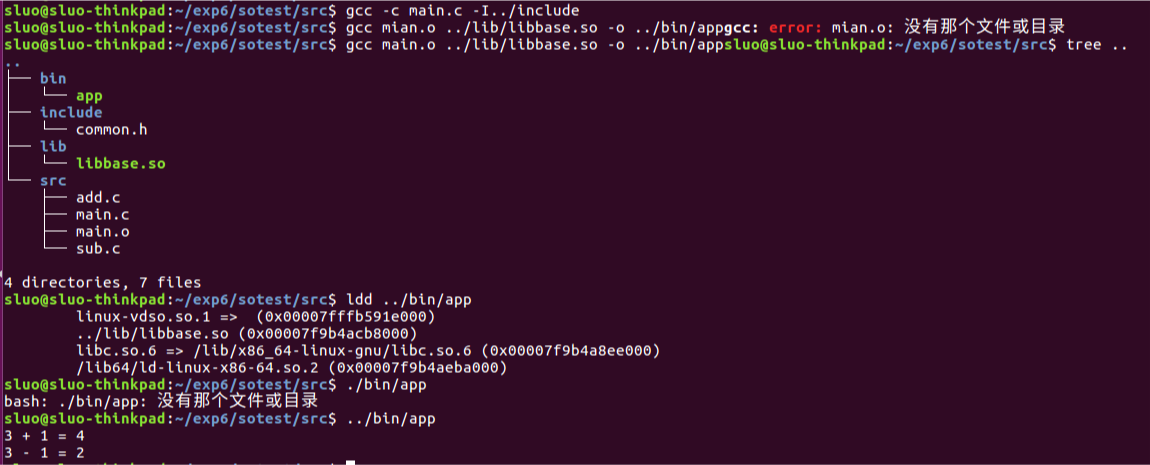
方式二:只给链接器动态库名称(若要正常实现,后面必须添加一个环境变量)

3、编程实现一个简单文件复制命令。(文件I/O)
#include <unistd.h>
#include <sys/types.h>
#include <sys/stat.h>
#include <fcntl.h>
#include <stdio.h>
#define BUFFERSIZE 4096
int main(int argc, char* argv[]) {
if (argc != 3) {
printf("usage:\n mycp src dst\n");
return 1;
}
int srcfd = open(argv[1], O_RDONLY);
if (srcfd == -1) {
perror("open");
return 1;
}
int dstfd = open(argv[2], O_CREAT | O_WRONLY, 0666);
if (dstfd == -1) {
close(srcfd);
perror("open");
return 1;
}
int len = 0;
char buffer[BUFFERSIZE] = {0};
while((len = read(srcfd, buffer, BUFFERSIZE)) > 0) {
if (write(dstfd, buffer, len) != len) {
perror("write error");
return 1;
}
}
if (len < 0) {
perror("read error");
return 1;
}
close(srcfd); // 关闭文件
close(dstfd);
return 0;
}

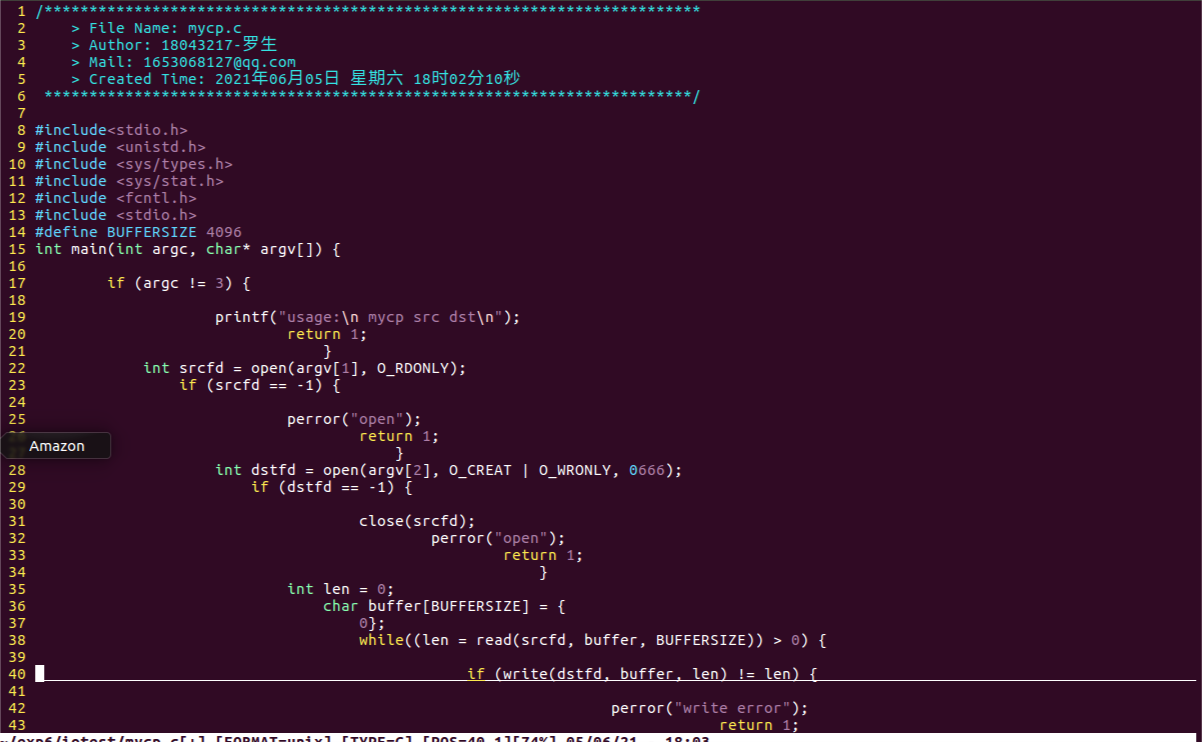
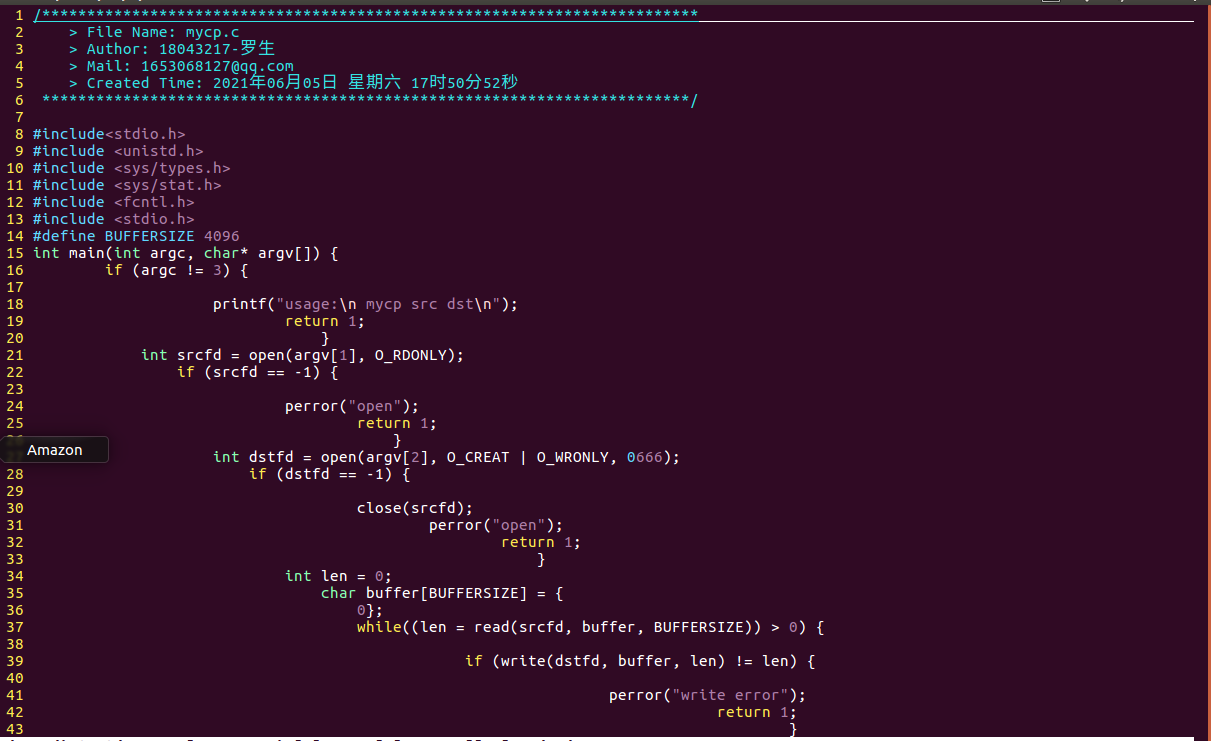
4、使用 fork 创建一个子进程,进程创建成功后父子进程分别输出不同的内容。
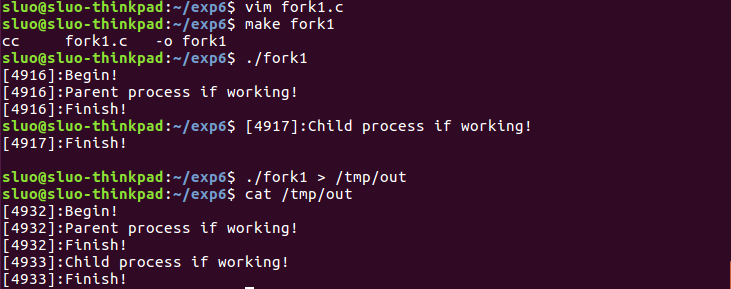
#include <stdio.h>
#include <stdlib.h>
#include <unistd.h>
int main(){
pid_t pid;
printf("[%d]:Begin! \n",getpid());
fflush(NULL);
pid = fork();
if(pid<0)
{
perror("fork()");
exit(1);
}
else if(pid > 0)
{
printf("[%d]:Parent process if working!\n",getpid());
}
else
{
printf("[%d]:Child process if working!\n",getpid());
}
printf("[%d]:Finish!\n",getpid());
return 0;
}
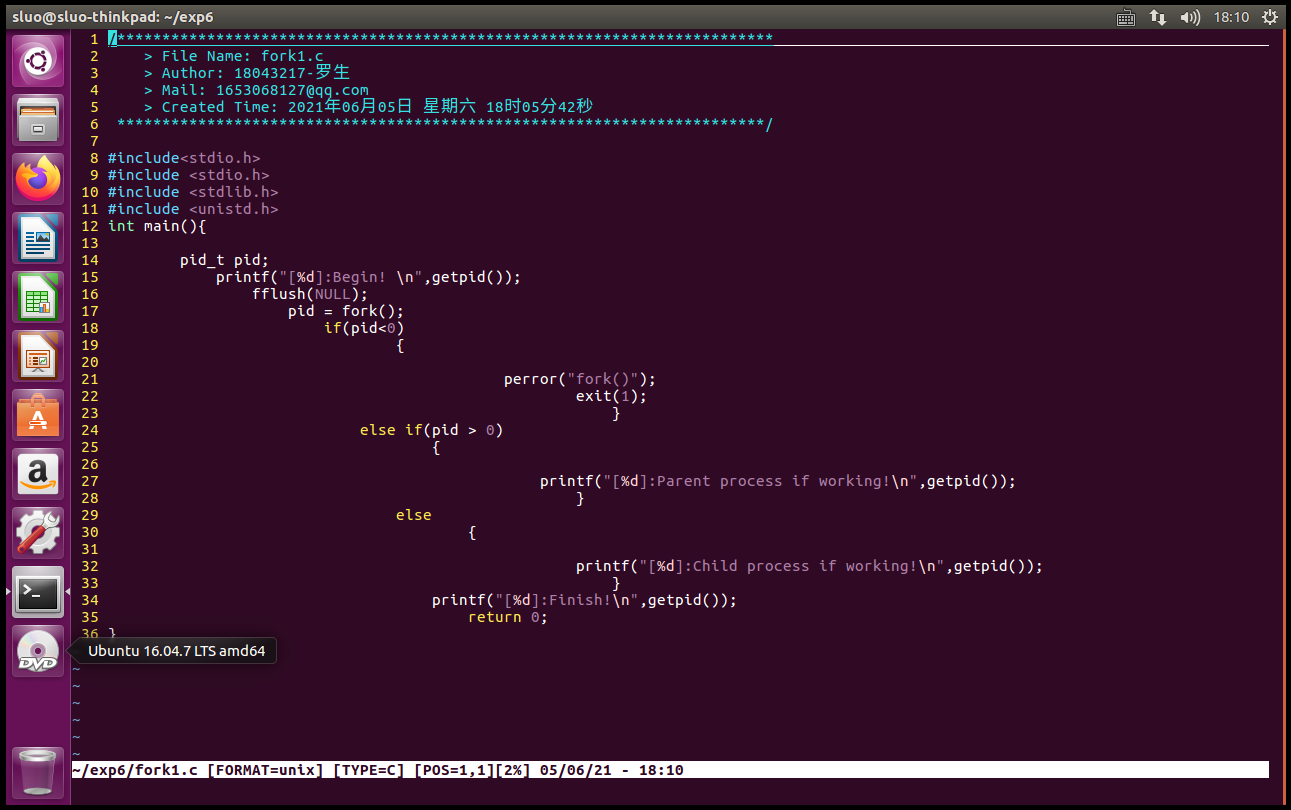
删除fflush(NULL);//查看运行结果区别
./fork1 > /tmp/out 输出结果删除后子程序工作前多个 Begin!
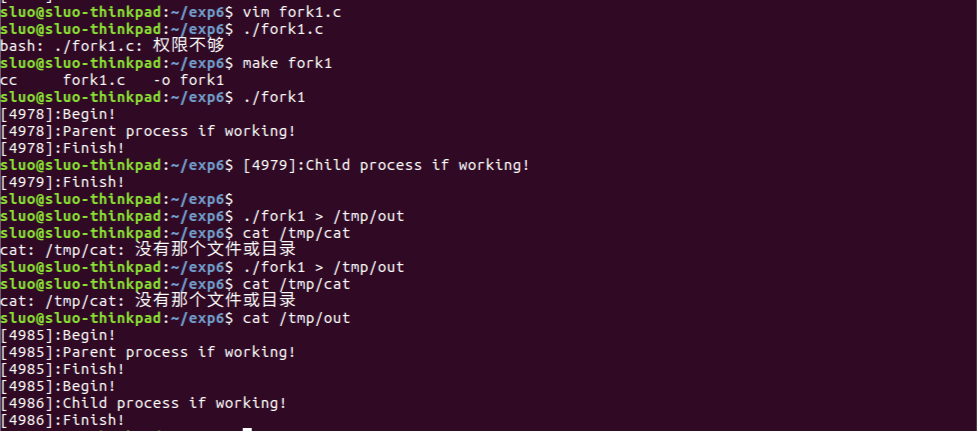
进一步删除15行 \n ,查看运行结果区别
删除后 Begin! 与 父进程、子进程间不换行
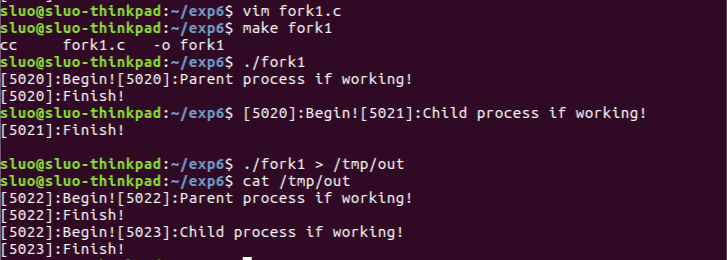
5、使用fork创建多个子进程。
int i;
pid_t pid;
for (i = 0; i < 3; i++)
pid = fork();
上面代码段会产生多少子进程?
2^3-1=7
产生7个子进程


使用sleep函数简单控制进程输出顺序

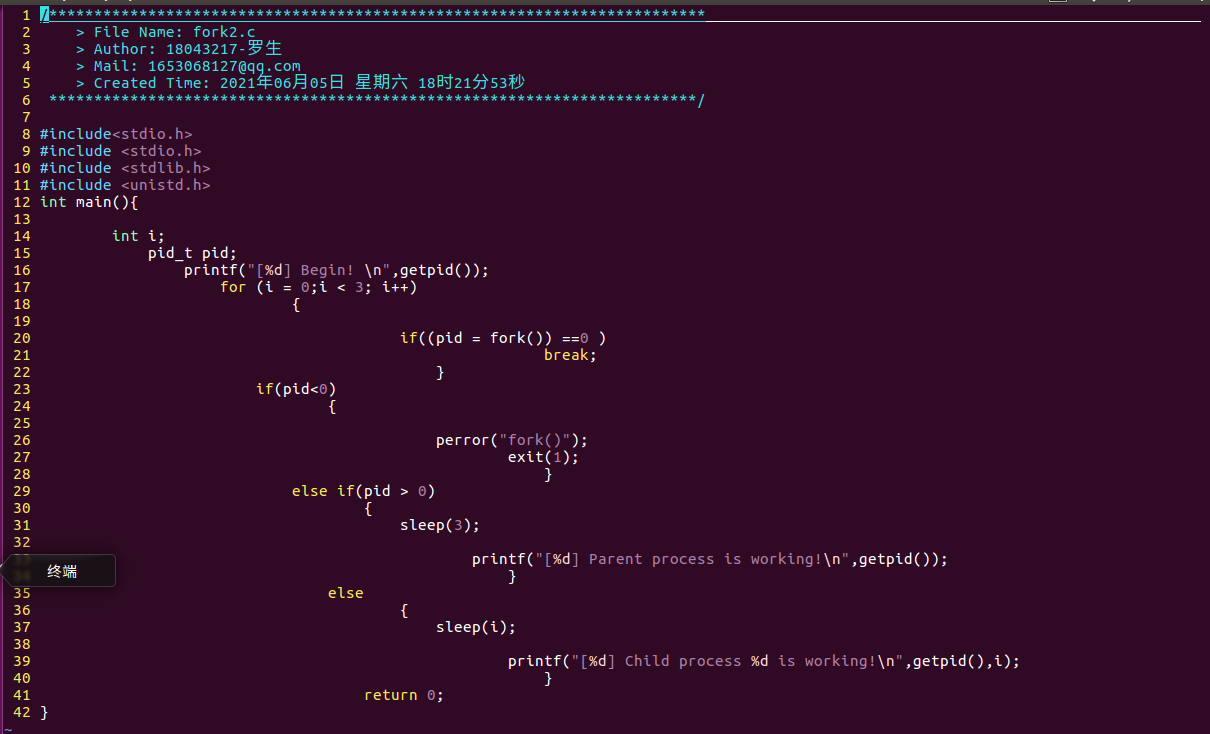
6、在 fork 之前以写的方式创建了一个文件 test.txt。然后 fork 出的子进程立即向文件中写入
“world”,然后睡眠5秒。而父进程在 fork 后睡眠3秒后向 test.txt 写入 "hello",并关闭描述符。子
进程恢复后,又向 test.txt 文件中写入 "lalala"后关闭描述符,结束。
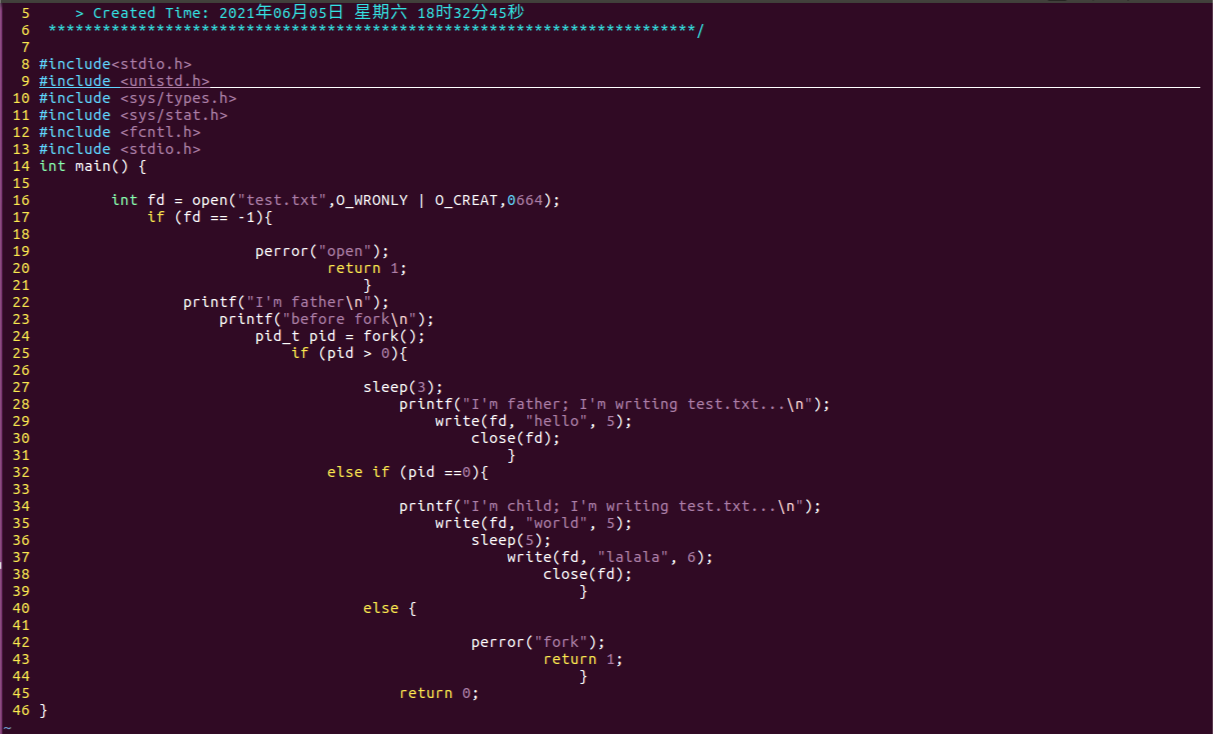

7、分别在主函数中使用
execvp 启动 ls 命令以及使用 fork 函数产生子进程调用 execvp 启动 ls 。
程序调用execvp,实现一个程序运行另一个程序
(1)使用execvp启动ls命令
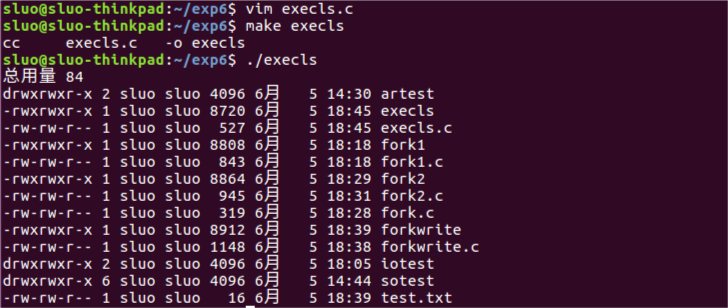

(2)使用fork函数产生子进程调用execvp启动ls
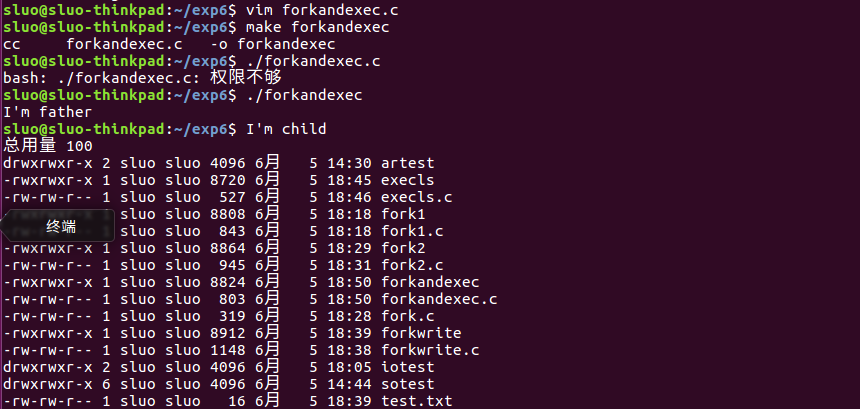
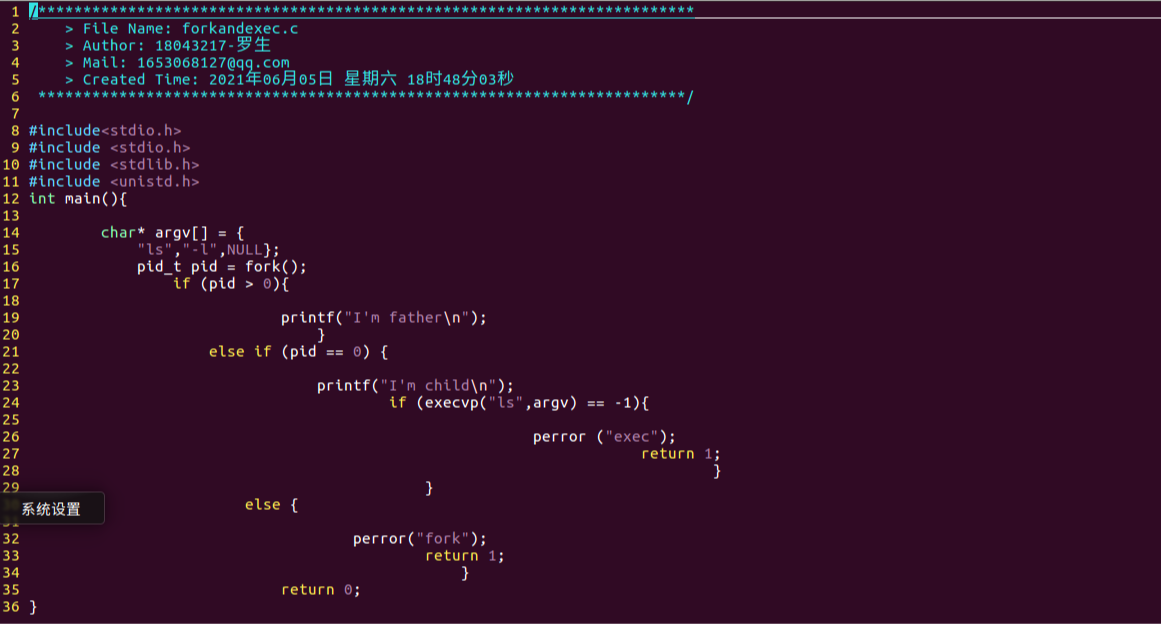
8、创建5个僵尸进程,并在终端通过 ps axf 命令查看僵尸进程信息。


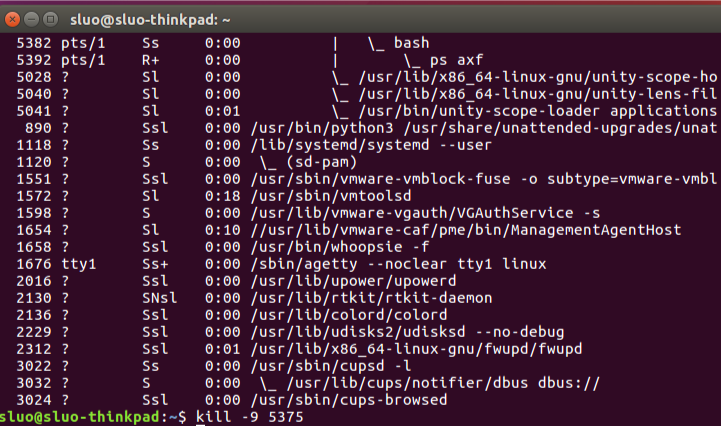
9、 通过 wait 来清理僵尸进程。
wait(等待子进程中断或结束)
(1)表头文件:
#include<sys/types.h>
#include<sys/wait.h>
(2)定义函数: pid_t wait (int * status);
(3)函数说明:
wait()会暂时停止目前进程的执行,直到有信号来到或子进程结束。如果在调用wait()时子进程已经结束,则wait()会立即返回子进程结束状态值。子进程的结束状态值会由参数status 返回,而子进程的进程识别码也会一快返回。如果不在意结束状态值,则参数status可以设成NULL。
(4)返回值:
如果执行成功则返回子进程识别码(PID),如果有错误发生则返回-1,失败原因存于errno 中。
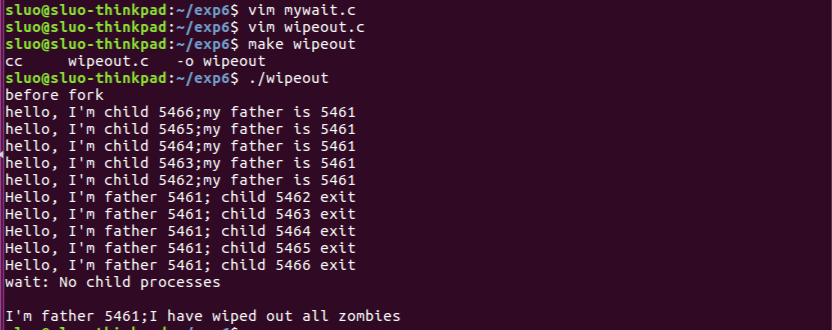
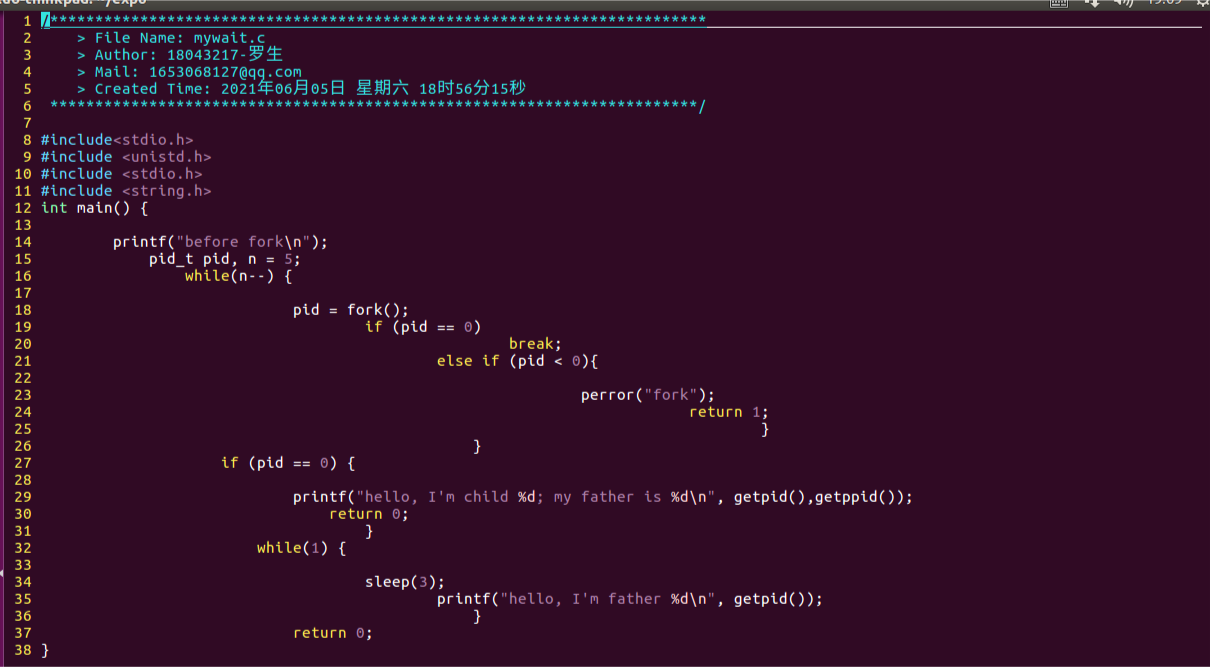
10、父进程通过 waitpid 函数等待特定子进程结束,若该子进程不结束,父进程一直阻塞。
waitpid
(1)函数功能:用来等待某个特定进程的结束
(2)函数原型:
pid_t waitpid(pid_t pid, int *status, int options);
(3)参数:
status如果不为空,会把状态信息写到它指向的位置
options允许改变waitpid的行为,最有用的一个选项是WNOHANG,它的作用是防止waitpid把调用者的执行挂起.
(4)返回值:成功返回等待子进程的pid,失败返回-1
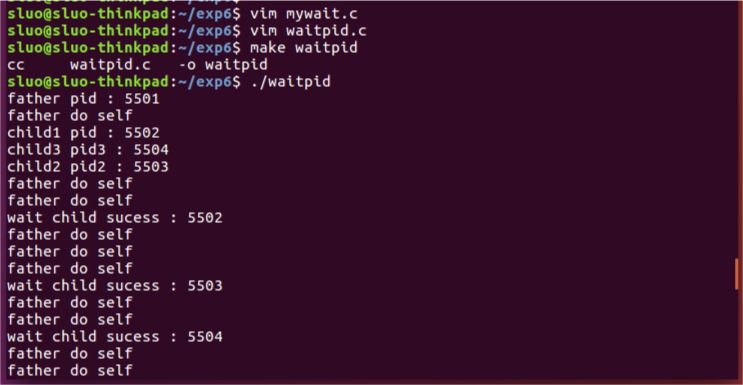
#include <stdio.h>
#include <signal.h>
#include <unistd.h>
#include <errno.h>
#include <sys/types.h>
#include <sys/wait.h>
#include <stdlib.h>
void handler(int sig)
{
pid_t pid;
while ((pid = waitpid(-1,NULL,WNOHANG)) > 0)
{
printf("wait child sucess : %d\n",pid);
}
}
int main()
{
signal(SIGCHLD,handler);
pid_t pid = fork();
if (pid == 0)
{
printf("child1 pid : %d\n",getpid());
sleep(3);
exit(1);
}
pid_t pid2 = fork();
if (pid2 == 0)
{
printf("child2 pid2 : %d\n",getpid());
sleep(5);
exit(2);
}
pid_t pid3 = fork();
if (pid3 == 0)
{
printf("child3 pid3 : %d\n",getpid());
sleep(7);
exit(3);
}
printf("father pid : %d\n",getpid());
while (1)
{
printf("father do self\n");
sleep(1);
}
return 0;
}
